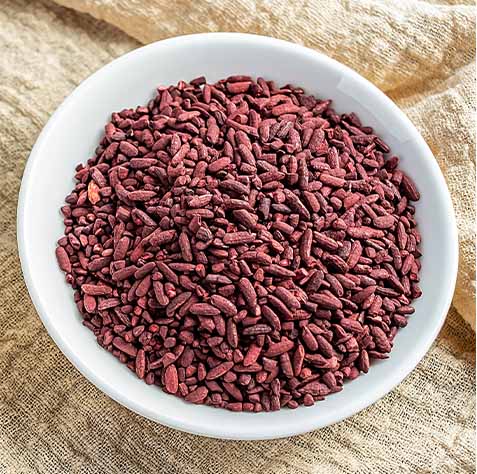Summarized and written by: Brenda Borba, RDN
If you’ve been hearing about red yeast rice (RYR) as a natural way to lower cholesterol, you’re not alone. Known also as Hong Qu, Hon-Chi, Anka, or red Koji, red yeast rice is a hot topic among those looking for alternative health solutions. But is it really effective and safe? Let’s dive into the research and facts about this intriguing supplement.
Red yeast rice is created by fermenting rice with the yeast Monacolin purpureus, turning the rice a distinctive red color. Historically, it’s been used in Chinese cuisine and medicine for over 1,000 years. The fermentation process can result in varying levels of monacolins, including monacolin K, which is chemically identical to the cholesterol-lowering drug lovastatin.
One of the significant issues with RYR supplements is inconsistency. A 2022 review by ConsumerLab.com revealed that RYR products often do not list the amount of monacolin K they contain, and the levels can vary greatly between products and even batches. Some supplements contained no monacolin K at all, while others had up to 7.5 mg per serving. This inconsistency raises questions about the efficacy and reliability of these supplements for lowering cholesterol.
Currently, there are no universally accepted guidelines for RYR dosages. Typically, doses range from 1,200 to 4,800 mg per day, divided into two doses. However, studies have shown mixed results regarding what constitutes a safe and effective dose. The lack of standardization makes it challenging to provide clear recommendations.
Research indicates that RYR may help lower cholesterol, blood glucose, and blood pressure, potentially reducing cardiovascular disease risk. For example, a Chinese study found RYR effective in reducing cholesterol levels. Systematic reviews and meta-analyses also suggest RYR can lower LDL cholesterol and total cholesterol levels. However, most studies have used a specific Chinese patented RYR product, not the supplements commonly found in U.S. stores.
Professional Recommendations
Different health organizations have varying stances on RYR:
- The European Society of Cardiology/European Atherosclerosis Society recommends RYR for patients with statin intolerance.
- China’s primary prevention guidelines for cardiovascular disease list a product called Xeuzhikang, a patented medicine with RYR as the main component.
- The 2021 European Society of Cardiology guidelines advise against using RYR supplements.
- The American College of Cardiology/American Heart Association guidelines do not mention RYR.
Safety is a significant concern with RYR supplements. The FDA has deemed some RYR products as unapproved drugs, restricting their monacolin K content. Potential side effects include abdominal discomfort, heartburn, and interactions with other medications, such as other statins and supplements. Additionally, there’s concern about citrinin contamination, a toxic byproduct of the fermentation process that can be nephrotoxic and possibly hepatotoxic.
While red yeast rice shows promise, especially for those intolerant to statins or seeking non-pharmaceutical options, it’s essential to approach with caution. Due to inconsistencies in supplement content and potential safety issues, always consult with a healthcare provider before starting RYR. Focus on dietary changes proven to reduce cardiovascular risk, such as the DASH, Mediterranean, and AHA diets.
For those considering RYR, look for brands reviewed by independent quality assurance organizations like ConsumerLab.com, the U.S. Pharmacopeia, and the National Safety Foundation. This can help ensure you are getting a product that is both safe and effective.
References:
Red Yeast Rice – Today’s Dietitian magazine. (n.d.). https://www.todaysdietitian.com/newarchives/0324p16.shtml
Mach F, Baigent C, Catapano AL, et al. 2019 ESC/EAS guidelines for the management of dyslipidaemias: lipid modification to reduce cardiovascular risk. Eur Heart J. 2020;41(1):111-188.
Hu D. Han Y, Ning G, Ma C. Chinese guideline on the primary prevention of cardiovascular diseases. Cardiology Discovery. 2021;1:70-104.
Pirro M, Vetrani C, Bianchi C, Mannarino MR, Bernini F, Rivellese AA. Joint position statement on “nutraceuticals for the treatment of hypercholesterolemia” of the Italian Society of Diabetology (SID) and of the Italian Society for the Study of Arteriosclerosis (SISA). Nutr Metab Cardiovasc Dis. 2017;27(1):2-17.
Cicero AFG, Colletti A, Bajraktari G, et al. Lipid lowering nutraceuticals in clinical practice: position paper from an International Lipid Expert Panel. Arch Med Sci. 2017;13(5):965-1005.
Arnett DK, Blumenthal RS, Albert MA, et al. 2019 ACC/AHA guideline on the primary prevention of cardiovascular disease: a report of the American College of Cardiology/American Heart Association Task Force on clinical practice guidelines. Circulation. 2019;140(11):e596-e646.
Yuan R, Yuan Y, Wang L, et al. Red yeast rice preparations reduce mortality, major cardiovascular adverse events, and risk factors for metabolic syndrome: a systematic review and meta-analysis. Front Pharmacol. 2022;13:744928.
Buzzelli L, Segreti A, Di Gioia D, et al. Alternative lipid lowering strategies: state-of-the-art review of red yeast rice. Fitoterapia. 2024;172:105719.
Mach F, Baigent C, Catapano AL, et al. 2019 ESC/EAS guidelines for the management of dyslipidaemias: lipid modification to reduce cardiovascular risk. Atherosclerosis. 2019;290:140-205.
Visseren FLJ, Mach F, Smulders YM, et al. 2021 ESC guidelines on cardiovascular disease prevention in clinical practice. Eur Heart J. 2021;42(34):3227-3337.
Red yeast rice: what you need to know. National Institutes of Health; National Center for Complementary and Integrative Health website. https://www.nccih.nih.gov/health/red-yeast-rice. Updated November 2022.

